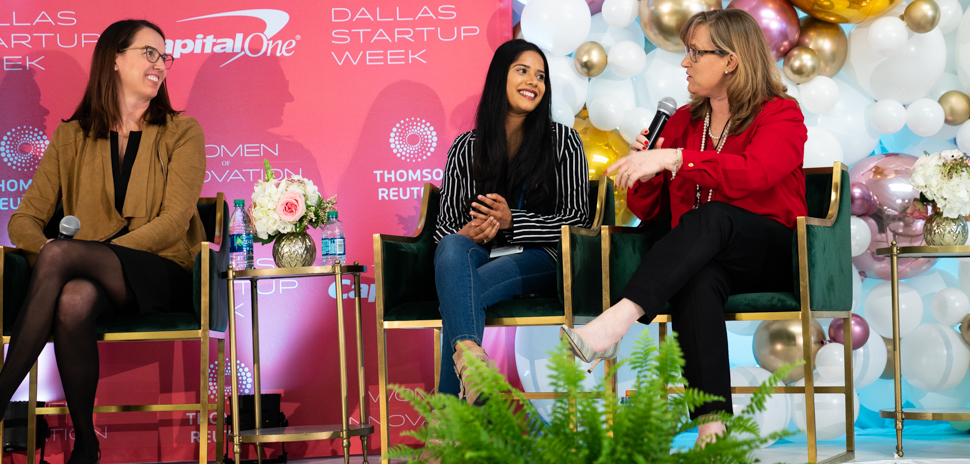Whether or not you realize it, you’re interacting with DARQ Power technologies every day.
DARQ—a subset of emerging technologies—includes distributed ledger (blockchain) tech, artificial intelligence, extended reality (VR/AR), and quantum computing.
Four Dallas women who are experts in their DARQ fields gathered Wednesday at Dallas Startup Week to discuss how their EmTech businesses are changing the world.
Panelists were Tiffany Ricks, CEO of Hacware; Kim Keating, vice president of data science at AT&T; Veena Somareddy, president, CTO, and co-founder of Neuro Rehab VR; and Teresa Anaya, director, financial institution strategy at Blockchain Intelligence Group. The panel was moderated by Michelle Williams, executive director, Southern Region, The DEC Network.
What is blockchain
FinTech expert Teresa Anaya has worked for the last 10 years in financial crime, learning about the failure of financial institutions, working on remediation projects, and investigating money laundering cases that involved cryptocurrency.
Anaya says blockchain was developed as an encrypted technology that’s able to transfer value from one individual to another. And, about the name, Anaya says, “basically you would take a hash of transactions. That hash is included in the next hash, and that then creates blocks, hence the word blockchain.”

Left to right: Michelle Williams, Tiffany Ricks, Kim Keating, Veena Somareddy, Teresa Anaya [Photo: Rebeca Posadas-Nava]
What is Artificial Intelligence
Keating says Artificial Intelligence is not a new technology—in fact, it’s been around since the 1950s. “It has gone through two hype cycles,” she says. “We didn’t have the computation and storage power in order to really make it real in applications. It became a big deal again in the 80s and 90s, but we were still in the same situation. We didn’t have the data storage in order to make it real.”
“Data scientists take very, very large datasets, and they apply algorithms to achieve the best outcome,” Keating says. “And then there’s this fantastic feedback loop, which is the key to AI, which uses big data to establish trends and make educated presumptions based on those trends.”
What is extended reality
Extended reality is a group of technologies involving virtual reality, augmented reality, and mixed reality. While these are generally seen as gaming devices, Somareddy is taking their application to a life-altering level.
Somareddy is the founder of Neuro Rehab VR, a developer of AR/VR physical and cognitive therapy exercises for neurological rehabilitation. She and her team use the tech to treat traumatic brain injuries and neurodegenerative diseases.
Somareddy says VR gives the user the impression they’ve been placed in another world. It’s a fully-immersive visual experience often delivered via a headset. AR, on the other hand, places a digital object into the physical world. See an example of AR in action here.
Mixed reality, meanwhile, creates a three dimensional projection of a digital object onto a surface. “So if this is your physical object, and you place it on the table, it will conform to the physical world.”
, “With VR, you are able to feel like you’re in a game. Ready Player One is a good example of VR. AR is where you have an object placed in the real world.

Left to right: Michelle Williams, Tiffany Ricks, Kim Keating [Photo: Rebeca Posadas-Nava]
Lowering the barrier to EmTech
The hardest part of getting into emerging technologies is learning the fundamentals, Somareddy says. Educational courses like those offered from Google, Amazon, Stanford, and Udemy can help introduce beginner EmTech workers find their way into the world of em tech.
But that can be difficult for beginners with limited internet access. Williams says one in five teens don’t have access to high speed internet. But AT&T is working to fix that.
“AT&T is one of the biggest investors in terms of capital buildout out in the country,” Keating says. “And one of our products that we’re building is high speed internet. So we really do focus on trying to increase the broadband penetration across the United States. It is really, really critical.”
Finding tech talent
Ricks says finding workforce talent with experience in big data has proven difficult. As a result, her organization aims to hire professionals with math and Python programming experience.
“We’re doing in house training for our engineers. So we will put a request out there for data scientists, for those big data engineers. But if we don’t get those capabilities, we’re looking for someone that has strong python programming,” she says. “And when we think about artificial intelligence, a lot of the algorithms that our data scientists use is all statistics. It’s all math.”
![]()
Get on the list.
Dallas Innovates, every day.
Sign up to keep your eye on what’s new and next in Dallas-Fort Worth, every day.





































































